|
|
| By Ross Lillistone
- Esk, Queensland - Australia
Boomed Vs Boomless
and a few other points about Rigs
|
|
 |
I’ve just read the article, “Traditional
Sailing Rigs and Performance” and I applaud
Michael Storer for illustrating some excellent points. However
there are a number of issues raised in the article about which
I would like to make comment.
Boomed Vs Boomless
The most important matter is that of Boomed Vs Boomless. The
article states that there are some people around who claim that,
“boomless rigs are highly efficient”. Who are these
people? What is meant by “efficient”?
Phoenix
III leading a Joel White-designed Pooduck Skiff
in a race to windward.
|
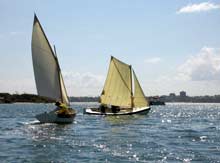
|
I have not come across anybody who claims that boomless rigs
are more efficient than the equivalent boomed rig on all points
of sail (assuming that Michael’s definition of efficiency
relates to aerodynamic efficiency alone – there are many
other ways of defining efficiency).
The use of a boomless rig is dictated by matters other than
aerodynamic efficiency, with the most important one being safety
when operating in open water. When an un-ballasted boat is over
pressed the best course of action is to head up into the wind
slightly, and as a last resort, ease the sheets. The problem
with a boomed sail is that the aft end of the boom can drag
in the water when the boat is heeling excessively, making it
impossible for the boom to swing to leeward, and even making
it difficult to head up into the wind by use of the rudder.
The inevitable result is a capsise. If you are just messing
around on an inshore race course that may not be a problem,
but for those of us who go out into the big water, it could
have very serious consequences.
If you look at working boats which used sail on a daily basis,
there are numerous examples of boomless rigs. I don’t
want to generalise too much, but a quick glance at the history
books will show just how prevalent boomless rigs were when people
relied on sail for their living. These people were not fools,
and their definition of “efficiency” covered some
important territory, including safety and lack of clutter. I
do not agree with Michael’s assertion that “boomless
sucks” and I think that it is neither prudent, nor polite,
of him to say, “Any designer who says that they are "efficient"
doesn't have enough sailing experience to make the call or is
getting carried away with the promotional spirit of things.”
A few of my friends and I have recently had an excellent opportunity
to compare a boomless rig with a boomed rig on my Phoenix
III design. Phoenix III is a relatively
narrow boat, being 4ft 9in over the gunwales (less to the outside
of the planking) on an overall length of 15ft 1-1/2in, so her
ability to stay on her feet was something to which I gave a
lot of thought. The primary rig was deliberately laid out to
allow the mainsail to be set correctly without a boom.
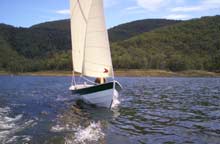 |
Head-on without boom –
no twist |
The term “correctly” refers to when the boat is
being sailed hard on the wind. On other points-of-sail the boomless
rig does not set in an optimum fashion, but nobody ever has
trouble making a boat go when reaching or running – regardless
of sail set.
| Reefed, lots of twist, but going fast |

|
In fact, the spritsail as used on Phoenix III is
very good in this regard anyway, due to the way the head of
the sail is controlled by the sprit.
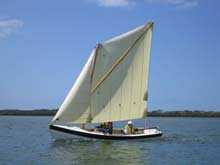 |
Sailing boomless |
| Sailing same rig with boom attached to mainsail |
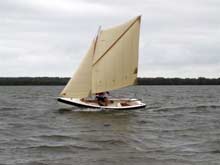
|
What has been discovered about sailing this boat, with and
without a boom, is not surprising to any of us: -
-
Without the boom, the mainsail can
be eased instantly and safely regardless of the angle of heel;
-
Without the boom there is less clutter
in the boat;
-
Without the boom, sheeting tension
is high (as is the case with a jib or staysail which is set
boomless);
-
Without a boom, the mainsail can be
brailed-up, clearing the interior of the boat instantly, and
providing a short-term furling arrangement;
-
Without the boom, selection of the
geometrically-correct sheeting point is critical and inflexible,
but fine control of sail camber on-the-wind is simple and
seamless.
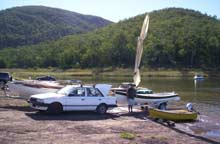 |
Brailed Up |
On the other hand,
-
With the boom, sheeting point is not
critical, and sheeting loads are reduced;
-
With the boom, short tacking can take
place with the sheet cleated, much reducing workload when
short-handed;
-
With the boom it is far easier to
maintain sail shape when the sheets are eased – particularly
if a boom-vang, wishbone, or sprit-boom is fitted.
Now, having said all that, I have to admit that it is more
convenient to use the rig with the boom attached, especially
in benign conditions, and I recommend a boom on Phoenix
III for general use. But when in the big stuff,
the boomless mainsail set-up is safer. It is great to have a
rig which can be used with or without a boom, and the change
over is almost instant.
Sail Twist
In his article, Michael Storer points out that one of the great
advantages of using some sort of vanging device (boom-vang,
sprit-boom, balanced lug with downhaul etc) is that it reduces
sail twist. This is a very good point, but there are certain
conditions under which 20 or 30 degrees of twist in the sail
is beneficial to windward performance. This is normally in very
light winds, which is also the time when it is most easy to
keep things under control without resorting to expensive and
highly-stressed rigging components!
| Boomless with sheet eased – plenty
of twist |
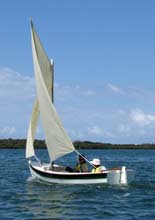
|
In the case of the spritsail, we have been using a very simple
and cheap piece of gear which has allowed us to keep sail twist
under good control – even when using the rig in a boomless
configuration. The device is a vang leading to the peak of the
sprit, and it cost around fifty cents. The sprit vang is not
highly loaded, and we made ours from a piece of 3mm (1/8in)
Venetian blind cord. Normally we run it through a small fairlead
on the rudder head and cleat it in a V-jamber on the tiller.
It does not need to be handled from tack to tack.
Congratulations to Michael Storer for bringing up the subject
of sensible sailing rigs for the sort of boat which is easy
to own and use.
|
 |
Click
here for more columns by Ross Lillistone
|
|

